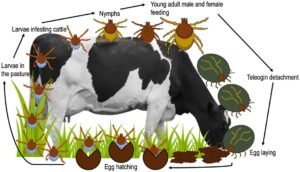Biological control of the Helioma tick in Iraq: New prospects for vector control

Dr. Majed Hamed Al Saegh / poultry pathologist / Australia
Introduction
Iraq is experiencing a sharp increase in cases of Crimean-Congo hemorrhagic fever (CCHF), a disease transmitted primarily by Helioma species of ticks. This increase is attributed to several factors, including favorable climatic conditions, traditional animal husbandry practices, and weak epidemiological surveillance systems. Although chemical pesticides remain the primary means of tick control, their overuse has led to the emergence of resistant strains and negative environmental impacts. Therefore, interest is turning to more sustainable alternatives, most notably biological control using entomopathogenic fungi.
Understanding the vector and the challenge in Iraq
Hyalomma marginatum and Hyalomma anatolicum are the predominant tick species in Iraq, well-adapted to dry and hot environments. These ticks are known for their aggressive behaviour and long feeding duration, making them highly effective CCHF vectors. They are commonly found on sheep, goats, cattle, and sometimes wild animals. Poorly regulated slaughter practices, lack of awareness, and the absence of systematic tick control programs in rural areas all contribute to the persistent risk of human infection.Tick activity peaks during spring and summer, coinciding with peak agricultural and animal-handling periods, which increases the likelihood of human exposure.
Fungi as a Natural Tick Control Tool
Entomopathogenic fungi such as Metarhizium anisopliae and Beauveria bassiana have shown significant potential for controlling tick populations. These fungi attach to the tick’s body, penetrate the outer shell, and grow inside, releasing toxins that kill the tick within a few days. This method is environmentally safe, non-toxic to humans and animals, and poses a very low risk of resistance. Recent field trials have clearly demonstrated their effectiveness:
In Pakistan, local strains of M. anisopliae were successfully used to reduce Hyalomma infestations on cattle.
In Spain, the application of B. bassiana spores in wild rabbit burrows led to a 78.6% reduction in Hyalomma lusitanicum populations within a month.
Additional trials in 2025 showed that combining fungal applications with traditional methods could significantly suppress tick populations without relying exclusively on chemicals.

Can This Be Applied in Iraq?
The short answer is yes—but with proper planning. The biggest challenge in Iraq is the harsh climate, where high temperatures and low humidity can reduce fungal viability. However, oil-based and nano-encapsulated formulations have recently been developed to protect fungal spores and maintain their activity even under extreme conditions. Currently, Iraq lacks large-scale facilities for fungal production. To address this, local universities and research centres could begin isolating native fungal strains and developing them for field use, particularly in livestock areas, shaded shelters, and near water sources.
Suggested Implementation Steps
1- Local research: Conduct studies to isolate fungal strains effective against Hyalomma under Iraqi conditions.
2- Formulation development: Use oil or nano-based carriers to enhance fungal survival in the field.
3- Training: Train veterinary staff and farmers on safe and practical application methods.
4- Community awareness: Educate the public about the benefits of biological methods and their safety compared to chemicals.
5- Policy support: Integrate biological control into national tick and zoonotic disease control programs.
Outlook
Biological control using entomopathogenic fungi offers Iraq a unique opportunity to tackle the growing challenge of tick-borne diseases in a sustainable and safe way. Unlike chemical methods, fungi do not pollute the environment or drive resistance and can be easily integrated into animal health programs. With political support, research partnerships, and community engagement, Iraq can become a regional leader in environmentally friendly tick control strategies, helping reduce disease burden and improving both human and animal health.



